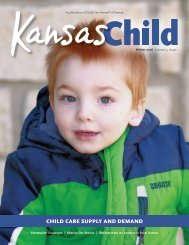2021Winter KansasChild_Final (4)
Create successful ePaper yourself
Turn your PDF publications into a flip-book with our unique Google optimized e-Paper software.
Child Care
IN
Kansas:
PARALYSIS TO ACTION
BY TRAVIS RICKFORD
Today, our rural way of life looks a little different as we adapt to
new challenges presented by COVID-19. Our work environments
look different, and we think twice about going to the local coffee
shop. Similar to the concerns about gathering over the holidays,
some of us might look at annual gatherings with more trepidation
than we have in the past. As we look at the community supports
that have been made available to help families through this global
crisis, the ability to access quality child care has been magnified to a
“higher than code red” designation.
Before COVID-19, rural communities were in crisis as they
explored ways to make child care more available. Businesses built
child care facilities for their employees, and daycares looked for
ways to expand. Communities created significant fundraising efforts
to build child care centers. However, problems related to sustainability
continued to exist. Before COVID, almost 80% of all
counties in Kansas reported that up to 10 children were waiting for
an opening (Child Care Aware of Kansas, 2019 Child Care Supply
Demand Report). In some counties, there are as many as 40 children
waiting for an opening. Again, this is before COVID-19.
With the onset of COVID-19, the child care gap was exacerbated
by closures of day cares. As the leader of a nonprofit, we are not
exempt from the problems created by COVID. In addition to our
regional initiatives, we operate two group child care facilities. On
average, we receive three heartbreaking calls a week asking for care
that we cannot provide. As I write this article, one of our facilities
is closed because of COVID. All of the preventative measures we
took could not hold back a deadly pandemic hell-bent on infiltrating
every aspect of our lives. So what do we do? How do we do it?
How can child care become something that families never again
have to worry about?
My preliminary response, like it tends to be with any adaptive
challenge, is to look toward community-centered approaches. As
community members, we sometimes have the best ideas, however,
we struggle to transform those ideas in action. The magnitude of
a problem like child care can paralyze us because it affects every
facet of our lives. This is not the first time an adaptive challenge has
presented an issue. Like child care, rural communities struggle to
provide resources to address mental health. When it was apparent
that services were not going to magically appear, the community,
particularly the sectors that make up the community (i.e. health,
government, education, etc.) had to participate in community conversations
and other participatory processes to make progress. I emphasize
the word progress, because issues such as mental health and
child care do not get resolved right away.
If we can focus on community-led “turning points,” or incremental
changes, we might be able to address these highly adaptive
challenges and not become overly dismayed in the process. As communities,
we need to continue to look at participatory approaches
to make progress before our paralysis turns into a vegetative state.
TRAVIS RICKFORD
Executive Director,
LiveWell Northwest Kansas
Travis Rickford serves as
the Executive Director for
LiveWell Northwest Kansas, a
regional nonprofit focused on improving
infrastructures for health, early childhood and
child care. Travis also serves as an adjunct
faculty member for the political science
department at Fort Hays State University.
He is pursuing his PhD in Leadership
Communications.
14
A Publication of Child Care Aware ® of Kansas
















